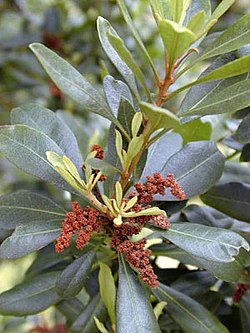| Myricaceae | |
|---|---|
 | |
| Myrica faya | |
| Scientific classification | |
| Kingdom: | Plantae |
| Clade: | Tracheophytes |
| Clade: | Angiosperms |
| Clade: | Eudicots |
| Clade: | Rosids |
| Order: | Fagales |
| Family: | Myricaceae A.Rich. ex Kunth [1] |
| Type genus | |
| Myrica L. 1753 | |
| Genera [2] | |
| |
 | |
| The range of Myricaceae | |
Myricaceae is a small family of dicotyledonous shrubs and small trees in the order Fagales. Its type genus is Myrica, the sweet gales. There are three genera in the family, [2] although some botanists separate many species from Myrica into a fourth genus Morella. About 55 species are usually accepted in Myrica (with Morella included), one in Canacomyrica , and one in Comptonia . [3]
Well-known members of this family include bayberry and sweetfern.
- Canacomyrica Guillaumin 1940
- Comptonia L'Hér. 1789
- Myrica L. 1753 (includes MorellaLour. 1790)